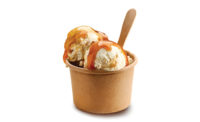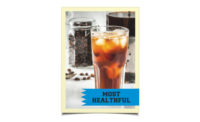Ice cream is back. Retail sales in the last year rose 6% and production rose 3.7% in 2015 from 2014 levels (the latest years available).
Milk | Cheese | Cultured | Ice Cream | Butter | Non-dairy Beverages | Ingredients | Exports
The comeback is welcome news to dairy processors after 2014, production tumbled 3.5% to 865.7 million gallons, according to the U.S. Department of Agriculture. But with 897.7 million gallons churned in 2015, ice cream production was at its highest level in five years. Even consumers had reason to be happy: prices were falling.
Retail sales, as measured by dollars, rose 6% to $5.9 billion and unit sales rose 6.5% to 1.5 billion. The average unit price dropped two cents to $3.77 in the 52 weeks ended Sept. 4, 2016, according to data compiled by Information Resources Inc. (IRI), Chicago. The Consumer Price Index put the price of a half-gallon package of ice cream at $4.71 in August 2016. The price peaked in April at $4.92.
IRI valued the ice cream and sherbet category at $11.4 billion. Ice cream and frozen novelties are the two largest segments, accounting for $10.8 billion in sales. Frozen yogurt/tofu, ice milk, ices and other products make up the rest of the category. Another research firm, Chicago-based Mintel, pegs the market at $12.6 billion and describes ice cream sales growth as “tepid.” From 2011 to 2015, Mintel figures dollar sales increased 6% but volume sales decreased 5%.
Though IRI statistics show unit sales of ice cream at retail are rising, research from Mintel found that 22% of consumers are buying less ice cream, 22% are buying premium ice cream and 34% say they would pay more for a premium ice cream than for a conventional product.
Another of Mintel’s findings that ice cream manufacturers should pay attention to is that consumers are eating ice cream as a snack almost as often as they eat it for dessert (49% compared to 55%, respectively). Sales of novelties actually grew faster than ice cream products, — 7% compared to 6.4% — according to IRI.
That plays in favor of Mars Ice Cream North America, Hackettstown, N.J. In December, it will release its M&M’s brand ice cream bars. The candies are embedded in reduced-fat vanilla ice cream and enrobed in milk chocolate. A box of six 1.63-ounce bars has a suggested retail price of $3.99. A single 2.64-ounce bar has a suggested price of $1.79.
The Ice Cream Club, a Boynton Beach, Fla.-based manufacturer that services scoop shops with tubs has a pilot program involving 3.6-ounce cups and pints, said CEO Rich Draper.
“Putting a heavy focus on quality, taste and health will resonate with consumers, and emphasizing single-serving packs and messaging around the variety of products should appeal to Americans’ preference for snacking,” said Beth Bloom, senior food and drink analyst at Mintel.
That single-serve portion has grown. This summer the Food & Drug Administration updated the Reference Amounts Customarily Consumed on the Nutrition Facts panel of packaged foods. What is now considered to be a serving of ice cream is two-thirds of a cup (about 5.3 ounces); it was one-half cup (4 ounces). This summer, Yuengling’s Ice Cream, Orwigsburg, Pa., amped things up with 8-ounce single-serve cups.
When it comes to picking a product off the shelf, consumers go for a private label ice cream. Sales and units outstrip any of the branded ice creams (see table on page 49). But what is notable is that unit sales of private label ice cream grew just 1.7%, while those of most of the top national brands grew faster, including Haagen-Dazs (14.3%), Turkey Hill (10.1%), Ben & Jerry’s (9.9%) and Wells Blue Bunny (8.1%).
There is no shortage of flavor ideas in the ice cream industry. Processors watch trends in the general food industry and develop their own flavors. Ingredient suppliers do the same and develop flavors and inclusions. New flavors from supplier Parker Products include raspberry buttermilk sherbet, Parmesan sables (with hazelnut ice cream and rosemary pecans) and salted gingerbread (a base of pumpkin ice cream with a salted caramel maple variegate).
Cleveland-based Pierre’s Ice Cream created three flavors for the summer: Campfire Toasted S’Mores (with marshmallows and graham cracker swirl), strawberry cheesecake and Sundae at the Museum. The latter is vanilla ice cream, pecans, salted caramel and fudge swirl. Pierre’s served 3,000 scoops at the Cleveland Museum of Art, which celebrated its centennial anniversary in June.
Recognized brand names can certainly help sales. Snoqualmie Ice Cream of Snohomish, Wash., has teamed with egg nog maker Sun Liquor for a seasonal flavor. Sun Liquor Fancy Egg Nog Frozen Custard is a nonalcoholic ice cream sold from September through December.
As fluid milk processors have discovered coffee, so have ice cream manufacturers. Hiland Dairy, Springfield, Mo., developed seal salt caramel espresso and caramel coffee products. Umpqua Ice Cream, Roseburg, Ore., offers Java Thunder with chocolate espresso bean pieces.
Dannon YoCream, Portland, Ore., expanded its sorbet line with two flavors: caramelized pineapple and passion orange guava. Citing research from restaurant industry consultant Technomic, Dannon said unique flavors can attract adventurous consumers. The frozen yogurts are sold to foodservice customers.
Ice cream restaurateurs are expanding to meet consumers who are dining out. In September, Carvel Ice Cream said it plans to open 20 stores in New Jersey. It said it achieved record same-store sales growth in 2015. Sub Zero Ice Cream, Provo, Utah, is franchisor of stores that prepare ice cream with liquid nitrogen in front of customers. The company said it plans to add 10 stores in Clark County, Nevada.
The popular frozen yogurt chain Pinkberry, Scottsdale, Ariz., added low-fat ice cream to its menus in June. Honeycomb Drizzle was a limited-time offer made with ice cream, honey and honeycomb.
Ingredients
Manufacturers are tinkering with formulas to clean up the labels. Perhaps the most notable manufacturer is Nestle. In April, the U.S. arm of the Swiss-based multinational food processors said it will remove artificial colors and flavors, high-fructose corn syrup and GMO ingredients from six brands, including Dreyer’s, Häagen-Dazs and Drumstick. It further pledged to use fresh milk from cows not treated with rBST, add real fruit or fruit juice and reduce sugar by an average of 11% on selected products.
Beginning in April, Nestle rebranded nine of Dreyer’s Slow Churned flavors as Slow Churned Simple Recipes. The improved recipes feature a label with seven or eight ingredients, reduced from an average of 22. Nestle replaced carrageenan and xantham gum with ingredients such as pectin.
Smaller manufacturers are making similar moves. Draper of The Ice Cream Club said “we began a move towards natural flavorings and colors a few years back.” He added that the most-asked-about ingredient is wheat gluten. The Ice Cream Club has 136 flavors without that ingredient.
J&J Snack Foods, Pennsauken, N.J., took the organic route for its Whole Fruit frozen novelties. The snacks company (it also makes soft pretzels and churros) said its 3-ounce juice tubes are free of dairy, fat, GMOs, high fructose corn syrup and gluten.
Nutritious or healthy?
Though ice cream is made with milk, no consumer would seriously consider the product to be a health food. Manufacturers do address health concerns with low-fat and no sugar-added varieties. Other ice cream manufacturers are going further.
For example, Thrive Frozen Nutrition, a 5-year-old company, makes a high-protein ice cream with 24 vitamins and minerals, natural soluble fiber and four strains of live and active probiotic cultures. In addition to selling pints to grocers, the company sells to health care institutions, collegiate athletic programs and U.S. military commissaries. The Orlando, Fla.-based company terms its premium ice cream “nutritious” not “healthy.”
Unlike some foods that are served to patients in health care settings, 95% of Thrive’s ice cream is consumed, which means that the nutrition in the food is actually delivered, Gessel said. Collegiate athletic programs have strict rules about what can be served at their training tables, he said, but Thrive’s nutritional content meets criteria.
The company redesigned the retail packaging and repositioned the product for supermarkets. Formerly, single-serve cups were merchandised among novelties and were getting overlooked, said Melanie Lux. Now packaged in pints, the product is next to other premium ice creams like Ben & Jerry’s, she said.
Outlook
With sales up and creative flavors hitting the market, ice cream makers generally are looking forward to the year. Draper of The Ice Cream Club said, “We remain optimistic due to population growth and our ongoing robust demand in the markets we serve.”
“People continue to enjoy ice cream and frozen treats,” said Matthew Thornicroft of Pierre’s Ice Cream. “Flavors may change over time. The types of treats and the way people enjoy them may change over time, but ice cream remains a popular indulgence. Listening to consumers, knowing their tastes and creating treats they want to enjoy is what keeps people interested in returning to the ice cream aisle.”
What’s the industry talking about?
- Retail sales rose 6%
- Retail prices are falling
- Production is up nearly 3.7%
- Consumers seek premium ice cream
- Single-serve cups offer shoppers choices
- Ice cream is now a snack
- Coffee and sea salt flavor ice cream
- Processors clean up their labels
- Restaurants build menus around ice cream
- Frozen yogurt sales are stalled
Milk | Cheese | Cultured | Ice Cream | Butter | Non-dairy Beverages | Ingredients | Exports












